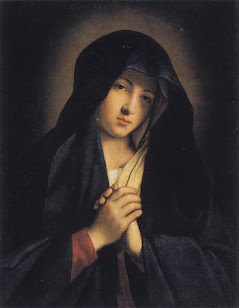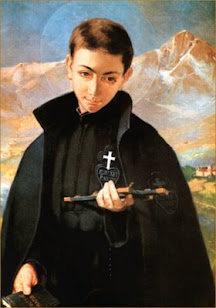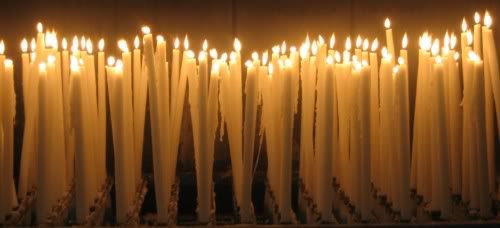The history of Christianity in Japan is long, and sadly quite brutal at times (see previous entry regarding Japanese Martyrs, here). The faith arrived in Japan in 1549, when Saint Francis Xavier landed at Satsuma. Having converted nearly 30,000 Japanese natives in a two year period, he was recalled to India and left the country. Thirty years later, over 200,000 Christians and 250 churches existed in Japan, with Jesuits and other missionaries working to spread the faith. At that time, Hideyoshi, the acting highest-ranked official of the emperor (referred to as taiko), had tolerance for the faith, despite the fear of his court. Many in Japan believed that the Europeans intended to invade the country, and that the Church was an invasion party in disguise.
On February 5, 1597, twenty-six Christians, including eight European missionaries, were publicly crucified at Nagasaki (see here). Hideyoshi, bowing to public pressure, had ordered the martyrdom in 1597. When he died the following year, a period of cooperative calm prevailed for the next decade. During that time, Christians flourished, with 130 Jesuits, joined by 30 Dominicans, Franciscans, Augustinians, and some secular priests staffing missions. Eventually, Tokugawa Ieyasu, opposed to the presence of the Church, became the shogun of Japan and published an edict abolishing Catholicism. Persecution began again, furthered by Tokugawa’s sons and heirs. In 1622, the “Great Martyrdom” took place at Nagasaki, claiming the lives of more that fifty Japanese and Europeans. Between 1624 and 1627, hundreds more were slain, imprisoned, or exiled. Most were burned alive, crucified, or beheaded, some with small children in their arms.
Among those martyred in 1622 was Carlo Spinola (1564-1622). Carlo was a Jesuit who had studied in Italy, where he was ordained. While he requested to participate in foreign missions, due to his poor health he was assigned to remain in Italy giving parish missions. Two years after he was ordained, and substantially recovered from ailment, Father Spinola finally was assigned to the mission in Japan. It took him six years, eight ships and great patience to arrive in Nagasaki, Japan after overcoming shipwrecks, pirates and many diplomatic and governmental obstacles.
Father Spinola arrived in Japan in 1602 where he studied Japanese, and was assigned to Minister at the Jesuit college of mathematics and astronomy in Kyoto. He later moved to Nagasaki, and the persecution of Christians began soon thereafter. The Shogun's decree banished all foreign missionaries and forbade Japanese Christians to harbor priests or practice their religion. Around 100 Jesuits left Japan, but some remained, among them Spinola who eluded the priest-hunters for four years. Since he could not disguise his European features, he went out only after dark. Finally on the night of Dec. 13, 1618 he was captured along with Brother Ambrose Fernandes and their catechist, John Chogoku. They were imprisoned for four years in an enclosure made of stakes, similar to a bird cage, which offered no protection from the elements, prior to their martyrdom.
Sebastian Kimura (1565-1622) was born of Christian parents in Hirado, where he came to know the Jesuits. He later studied at the seminary in Arima and in 1582 joined the Society. He served as a catechist in Miyako before studying theology in Macao; he was ordained in Nagasaki in September 1601. An eloquent preacher, he became very skilled at disguising himself once Jesuits were banned. He might appear as a soldier, merchant, or physician—giving him freedom to visit Christians and administer the sacraments. The police became aware of his activity and wanted badly to catch him, so his provincial ordered him to leave Nagasaki until the pressure eased. Before he could obey, he was arrested along with his catechist, Thomas Akahoshi, and an assistant at the Jesuit residence, Louis Kawara. The three were sent to the prison in Suzuta along with Spinola and the other Christians.
Ambrose Fernandes (1551-16-22) was born in Portugal and arrived in Japan following a shipwreck and a pledge to the Lord that if he survived, he would become a Jesuit. He survived, and entered the novitiate in Nagasaki as a brother in January 1579. He took care of material needs at the Jesuit community, but went undercover when the Jesuits were expelled. He was arrested with Father Spinola and imprisoned for 13 months after which he died due to exposure.
Father Spinola managed to obtain what was needed for Mass, which he celebrated daily. He even started a novitiate for seven imprisoned catechists who wanted to become Jesuits. When Spinola learned in September 1622 that they were to be taken to Nagasaki, he thought they would be executed, so he accepted the vows of his seven novices.
John Chugoku was born in Yamaguchi, Japan, about 1573. He served with an influential knight and accompanied him on an invasion of Korea. After he returned to Japan, he came into contact with Jesuits. He began accompanying them on their missionary journeys and was eventually arrested with Spinola and Fernandes. John made his Jesuit novitiate in prison at Suzuta and pronounced his vows days before being beheaded.
Anthony Kiuni also came from a noble family. He became a catechist and worked with Jesuits in their printing press and the infirmary. With the Jesuits he went into exile in Macao in 1614, but returned three years later to live the life of a hermit. He picked a secluded spot on a mountain near Nagasaki. Michael Shumpo and Gonzalo Fusai joined him there and all were arrested in 1619 and taken to the former Jesuit novitiate in Nagasaki. Their novitiate began the next year when they were transferred to the prison in Suzuta and Father Spinola could direct them.
Michael Shumpo was born into a Christian family in Owari, Japan, and entered the seminary in Arima. Later he became a catechist and sacristan of the church in Miyako. He went into exile but returned in 1617 to join Anthony Kiuni in his mountain hermitage. With Kyuni he was arrested and taken to Nagasaki.
Gonzalo Fusai came from a noble family in Okayama, Japan, where he was born about 1580. He served the daimyo of Bizen-Mimasaka and accompanied his lord during a military campaign in Korea. Later he left his position to move to Nagasaki where he became a Christian and served as a catechist. After exile in Macao, he joined his friends Michael Shumpo and Anthony Kyuni.
Peter Sampo was born in Oshu, Japan, around 1580. He emigrated to central Japan where he reached his goal of gaining a good position with a great lord; then later he moved again to Hiroshima where he became a Christian. He shaved his head and built a simple house right next to the Jesuit novitiate. Upon the advice of his neighbor, he became a catechist, later going into exile with the Jesuits. He returned to Japan and secretly resumed his work as a catechist before joining Anthony Kiuni's group on the mountain.
Louis Kawara (1583-1622) served in the court of Michael, prince of Arima, who renounced the Christian faith and was angered when Louis failed to follow suit. With his family, Louis moved to Nagasaki where they lived in abject poverty; eventually his wife and children died. Louis built himself a small house in a remote area and lived as an ascetic. People came to visit him and listen to his wisdom, eventually leading to his arrest on three occasions. He was arrested with Fr. Kimura and imprisoned in Suzuta. Moved by the example of the others he met there, he entered the Society and pronounced his vows before being burned alive.
Thomas Akahoshi was born at Higo, Japan, around 1565. After his wife died, Thomas went to Nagasaki and became a catechist with the Jesuits. He went into exile with them in 1614, but returned with Father Kimura to Japan. The two were arrested together. Akahoshi entered the Society in prison at Suzuta and pronounced his vows before being burned alive.
Wearing cassocks smuggled into prison, they were led to Martyrs' Hill outside Nagasaki and tied to stakes to suffer death by "slow fire." Prior to the executions of these religious Dominicans, Franciscans, Augustinians and Jesuits, they were forced to watch the beheading of about 30 of the faithful—including men, women, and children as young as seven years old. Weakened by four years' imprisonment, Spinola died one half hour after the fire was lit. When fastened to the stake, he intoned the psalm, "Praise the Lord, All You Nations," and led the other martyrs in a song of thanksgiving to God for being called to witness to their faith.
Others who were martyred on September 10, 1622:
Blessed Cosmos and Agnes Takea, husband and wife
Blessed Anthony of Korea, Jesuit assistant (and son Blessed John of Korea)
Blessed Anthony Sanga, Catechist, and wife Blessed Magdalen Sanga (and three-year old son, Blessed Peter Sanga)
Blessed Anthony Vom
Blessed Bartholomew Shikiemon
Blessed Paul and Thecla Nangashi, husband and wife (and seven-year old son, Blessed Peter)
Blessed Thomas of the Holy Rosary, Dominican
Blessed Thomas Shikuiro
Blessed Damien Yamiki and five-year old son Blessed Michael Yamiki
Blessed Dominic Nakano, son of Blessed Mattias Nakano
Blessed Dominic and Clare Shamada, husband and wife
Saint Dominic Shamada, Dominican
Blessed John Kingoku, Catechist
Blessed Joseph of St. Hyacinth, Dominican
Blessed Leo Satsuma, Franciscan
Blessed Mary Tokuan and Mary Choun, wives slain with their husbands
Blessed Mary Tanuaura
Blessed Paul and Blessed Mary Tanaka, husband and wife
Blessed Peter of Avila, Franciscan
 205 Martyrs of Japan, including the "Great" martyrs celebrated today, were beatified in 1867, recalling their heroic sacrifice and struggle in spreading the Gospel and courageously living their faith.
205 Martyrs of Japan, including the "Great" martyrs celebrated today, were beatified in 1867, recalling their heroic sacrifice and struggle in spreading the Gospel and courageously living their faith.O God our Father, who art the source of strength to all thy saints, and who didst bring the holy martyrs of Japan through the suffering of the cross to the joys of life eternal: Grant that we, being encouraged by their example, may hold fast the faith that we profess, even unto death; through Jesus Christ our Lord, who liveth and reigneth with thee and the Holy Spirit, one God, now and for ever. Amen.
Inspired by the origins and spiritual history of the Holy Rosary, we continue our meditation on the psalms, one each day, in order, for 150 days.
Psalm: Psalm 138: Hymn of a Grateful Heart
1 I will praise you, O LORD, with all my heart;
before the "gods" I will sing your praise.
2 I will bow down toward your holy temple
and will praise your name
for your love and your faithfulness,
for you have exalted above all things
your name and your word.
3 When I called, you answered me;
you made me bold and stouthearted.
4 May all the kings of the earth praise you, O LORD,
when they hear the words of your mouth.
5 May they sing of the ways of the LORD,
for the glory of the LORD is great.
6 Though the LORD is on high, he looks upon the lowly,
but the proud he knows from afar.
7 Though I walk in the midst of trouble,
you preserve my life;
you stretch out your hand against the anger of my foes,
with your right hand you save me.
8 The LORD will fulfill his purpose for me;
your love, O LORD, endures forever—
do not abandon the works of your hands.
Day 252 of 365
Prayer Intentions: Courage to live the Gospel.
Requested Intentions: For a daughter’s successful relationship (M); For a relationship sanctified by God (M); For health of father; For canonization of Pope John Paul II (A); For the conversion of a family (L); For the ill (A); For the health of a family (I); For a father’s successful surgery and recovery (G); For those who are ill, and their caretakers (D); For the safety of a sister who is traveling (A); Recovery of mother with cancer (R); Successful acquisition of a visa (T); Restoration of a marriage (A); For employment and health of mother (G); Successful employment (M); Restoration of a family, End to brother's addiction, Successful marriage (R); Employment (I); Successful recovery of a mother; for all stroke victims (D); Successful return to the faith (A); Emotional, physical, and financial healing (D); Diagnosis and recovery (A); For a successful relationship (J); Those suffering from depression (J); Successful adoption (S); Healing of a father battling cancer (S).
Psalm: Psalm 138: Hymn of a Grateful Heart















0 comments:
Post a Comment
Thanks for leaving a comment. If you wish to submit a prayer request, however, please do so above, using the "Contact" tab.